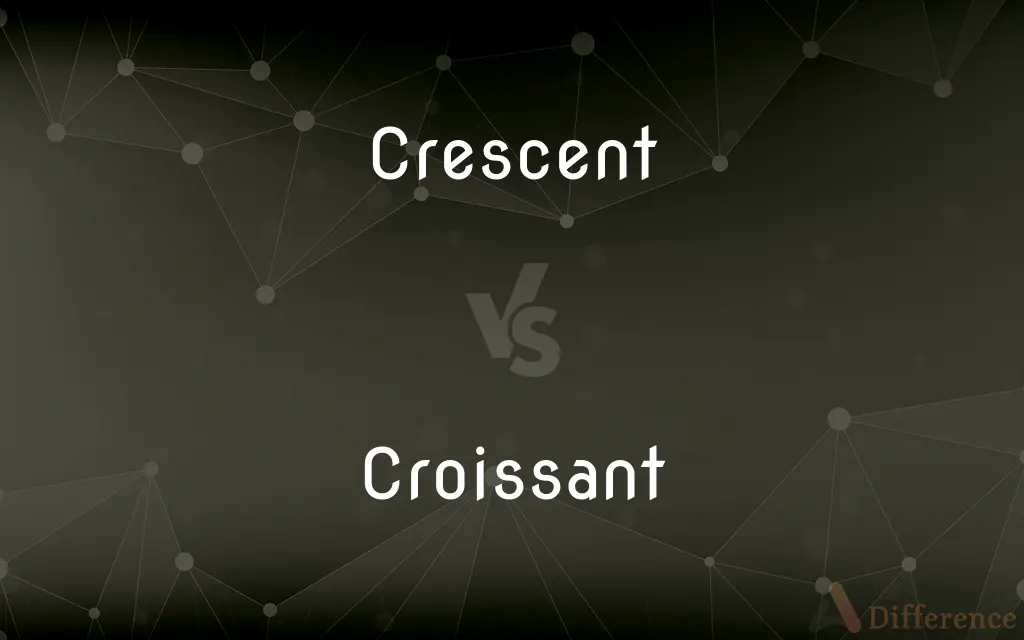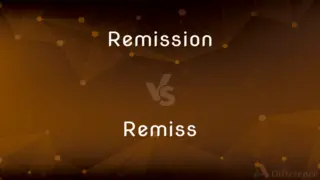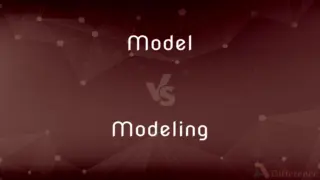Crescent vs. Croissant — What's the Difference?
By Fiza Rafique & Maham Liaqat — Updated on March 6, 2024
Crescent is a moon phase shape, while a croissant is a buttery pastry.

Difference Between Crescent and Croissant
Table of Contents
ADVERTISEMENT
Key Differences
A crescent is a symbol or shape that resembles the moon in its first or last quarter, characterized by its curved, sickle-like form. It represents various cultural, religious, and national symbols around the world. On the other hand, a croissant is a flaky, buttery pastry of Austrian origin, popularized in France, known for its crescent shape and layers of puff pastry.
While the crescent is primarily a geometric or symbolic representation found in nature and iconography, the croissant is a tangible, edible item enjoyed by people globally. The crescent's significance varies greatly across different cultures and contexts, symbolizing everything from fertility to the cycles of nature, whereas the croissant's importance lies in its culinary delight and cultural heritage, particularly in French cuisine.
The crescent shape is versatile, appearing not only in celestial observations but also in art, flags, and emblems, symbolizing various meanings from Islam to heraldry. In contrast, the croissant's shape, while inspired by the crescent, is celebrated for its culinary craftsmanship, the technique of layering dough and butter, and the resulting delicate, airy texture after baking.
Crescents in various forms have been used for millennia, with their representations dating back to ancient civilizations, where they were often associated with lunar deities or phenomena. Croissants, however, have a more recent history, with their development and popularization in Europe occurring over the past few centuries, becoming a staple of French bakeries and breakfast tables.
The term crescent can be applied broadly, from describing the moon's shape at certain times to its use in various symbolic contexts. A croissant, by definition, is specific to the culinary world, denoting a particular type of pastry known for its buttery taste, flaky texture, and complex method of preparation that involves repeatedly folding and rolling to create layers.
ADVERTISEMENT
Comparison Chart
Definition
A shape resembling the moon in its first or last quarter.
A flaky, buttery pastry made from layered dough.
Origin
Symbolic and natural, seen in celestial bodies.
Culinary, originating in Austria and popularized in France.
Significance
Varied, from religious to cultural symbols.
Culinary delight with a focus on craftsmanship.
Representation
Broad, including celestial, artistic, and symbolic uses.
Specific to a type of pastry.
Historical Usage
Millennia-old, symbolizing various concepts.
Relatively recent, developed over the past few centuries.
Compare with Definitions
Crescent
Represented in various flags and emblems.
The crescent appears on several national flags.
Croissant
A buttery, flaky pastry originating from Austria.
She enjoyed a warm croissant with her morning coffee.
Crescent
A symbol or shape resembling the moon's phase.
The crescent moon shone brightly in the night sky.
Croissant
Celebrated for its culinary craftsmanship.
The chef's croissants are famed for their perfect texture and taste.
Crescent
A shape that has been a part of human symbolism for millennia.
Ancient civilizations revered the crescent in their artworks.
Croissant
Involves a complex method of preparation.
Making a croissant requires skill in layering dough and butter.
Crescent
Symbolizes different meanings across cultures.
In some cultures, the crescent is a symbol of fertility.
Croissant
Known for its crescent shape and layers of dough.
The croissant's delicate layers are achieved through careful folding.
Crescent
Often associated with the lunar cycle.
The calendar months were marked by the crescent phases.
Croissant
A staple of French bakeries and breakfasts.
Croissants are a common sight in Parisian cafes.
Crescent
The curved sickle shape of the waxing or waning moon
The moon was a slender crescent
Croissant
A French crescent-shaped roll made of sweet flaky yeast dough, eaten for breakfast.
Crescent
A thing which has the shape of a single curve that is broad in the centre and tapers to a point at each end
A three-mile crescent of golden sand
Croissant
A rich, crescent-shaped roll of leavened dough or puff pastry.
Crescent
A crescent shape (, British English also ) is a symbol or emblem used to represent the lunar phase in the first quarter (the "sickle moon"), or by extension a symbol representing the Moon itself. In Hinduism, Lord Shiva is often shown wearing a crescent moon on his head symbolising that the lord is the master of time and is himself timeless.
Croissant
A flaky roll or pastry in a form of a crescent.
Croissant
Very rich flaky crescent-shaped roll
Common Curiosities
What defines a crescent shape?
A crescent shape is defined by its curved, sickle-like form, resembling the moon in its first or last quarter.
Can crescents be found in nature outside of the lunar context?
While crescents are most commonly associated with the lunar phase, similar shapes can occur naturally, like in the curvature of a leaf or a smile.
How did the croissant get its shape?
The croissant's crescent shape is inspired by the lunar crescent, a design choice thought to celebrate a historical event or mimic the moon's shape.
What makes a croissant unique in its preparation?
A croissant's uniqueness lies in its method of preparation, involving folding and rolling dough with butter to create multiple layers.
Does the crescent have universal symbolism?
The crescent's symbolism varies widely across different cultures and contexts, from representing lunar deities to serving as a national emblem.
Are all crescents symbolic?
Not all crescents are inherently symbolic; their significance depends on the context in which they are used or observed.
Is there a difference in taste between different types of croissants?
Yes, the taste of a croissant can vary based on the ingredients, butter quality, and preparation technique used by the baker.
Are there variations of the croissant in other cuisines?
Yes, many cultures have adopted and adapted the croissant, creating variations that incorporate local flavors and ingredients.
Why is the croissant associated with French cuisine if it originated in Austria?
The croissant became associated with French cuisine through its popularization and refinement in France, where it was embraced and became a culinary staple.
How do dietary concerns affect the consumption of croissants?
Dietary concerns, such as allergies to gluten or lactose intolerance, can limit the consumption of traditional croissants, leading to the development of alternative recipes.
What occasions are croissants typically served at?
Croissants are commonly served at breakfast or as snacks, but they can also be part of a brunch menu or paired with coffee.
Can the crescent shape be patented or trademarked?
While specific designs incorporating a crescent shape can be trademarked, the basic crescent shape itself is too generic for intellectual property rights.
How is the crescent depicted in modern design and architecture?
In modern design and architecture, the crescent can be a motif used for its aesthetic appeal or symbolic value, often seen in logos, decorations, and structures.
Why is the crescent a popular symbol in Islam?
The crescent is popular in Islam as a symbol representing the beginning of the lunar month, including Ramadan, and has historical and cultural significance.
Can croissants be filled with other ingredients?
Yes, croissants can be filled with a variety of ingredients, such as chocolate, almond paste, or ham and cheese, creating different flavors and textures.
Share Your Discovery

Previous Comparison
Remission vs. Remiss
Next Comparison
Model vs. ModelingAuthor Spotlight
Written by
Fiza RafiqueFiza Rafique is a skilled content writer at AskDifference.com, where she meticulously refines and enhances written pieces. Drawing from her vast editorial expertise, Fiza ensures clarity, accuracy, and precision in every article. Passionate about language, she continually seeks to elevate the quality of content for readers worldwide.
Co-written by
Maham Liaqat















































